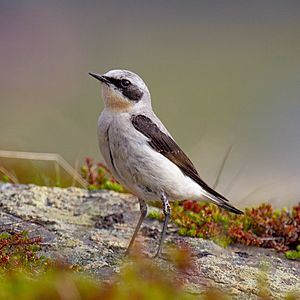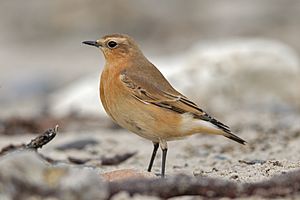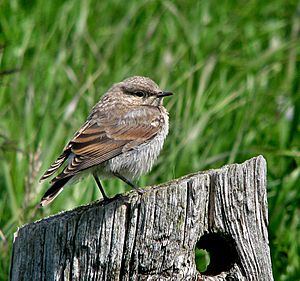Northern wheatear facts for kids
Quick facts for kids Northern wheatear |
|
|---|---|
 |
|
| Male in breeding-plumage | |
 |
|
| Female | |
| Conservation status | |
| Scientific classification | |
 |
|
| Synonyms | |
|
Motacilla Oenanthe Linnaeus, 1758 |
The northern wheatear (Oenanthe oenanthe) is a small bird. It used to be grouped with thrushes, but now scientists consider it an Old World flycatcher. This bird is the most common type of wheatear found across Europe and a large part of Asia.
Northern wheatears are migratory birds, meaning they travel long distances. They eat insects. They build their nests in rocky areas, like cracks in rocks or rabbit burrows. You can find them breeding in Europe, Asia, Greenland, and parts of Canada and Alaska. All northern wheatears spend most of their winter in Africa.
Contents
About the Northern Wheatear
The northern wheatear is a bit bigger than a European robin. It is about 14.5 to 16 centimeters (5.7 to 6.3 inches) long. Its wingspan is about 26 to 32 centimeters (10 to 12.5 inches). These birds usually weigh between 17 and 30 grams (0.6 to 1.1 ounces).
Both male and female wheatears have a white patch on their lower back and tail. Their tail also has a black T-shape at the end.
How to Spot a Northern Wheatear
In summer, male northern wheatears have grey backs. Their throats are a light brown color, and their wings and face look black. In autumn, the male looks more like the female, but its wings stay black.
Female wheatears are light brown on top and light brown underneath. Their wings are a darker brown.
The male wheatear has a song that sounds like whistling and crackling. Their call is a short chack sound.
Amazing Migrations
The northern wheatear makes one of the longest journeys of any small bird. They fly across oceans, ice, and deserts. They travel from Sub-Saharan Africa in spring to breed in the Northern Hemisphere. This huge area includes northern and central Asia, Europe, Greenland, Alaska, and parts of Canada. In autumn, all these birds fly back to Africa.
Some northern wheatears that breed in northern Asia could fly a shorter way to winter in southern Asia. But they are born with the instinct to fly all the way back to Africa. This makes their journey one of the longest for a bird of its size.
Longest Flight for a Songbird
Birds from Greenland, which are a larger and brighter type called leucorhoa, make a very long trip over the ocean. In spring, most fly from Africa, through Europe, the British Isles, and Iceland, to Greenland.
Scientists have used tiny tracking devices to follow these birds. They found that the northern wheatear has one of the longest migratory flights known. Some birds travel 30,000 kilometers (18,640 miles) from Africa to their breeding grounds in the Arctic.
Birds from Alaska travel almost 15,000 kilometers (9,000 miles) one way. They cross Siberia and the Arabian Desert. On average, they fly about 290 kilometers (180 miles) each day. This is the longest recorded migration for a songbird.
Life Cycle and Reproduction
Northern wheatears start to breed when they are one year old. The female builds the nest all by herself. The male stays nearby, singing and sometimes flying around to show off.
The nest is usually in a hidden spot. This could be a rabbit burrow, a crack in the rocks, or even a hole in a wall or pipe made by humans. The nest is built with plant materials. The inside is lined with softer things like fine grasses, leaves, moss, and lichen.
The female lays one egg each day. A group of eggs, called a clutch, usually has 4 to 7 eggs. The eggs are about 21 by 15.8 millimeters (0.83 by 0.62 inches) in size. They weigh about 2.83 grams (0.1 ounces). The eggs are a very pale blue color. Sometimes they have a few reddish-brown spots on the larger end.
The female does almost all the incubating, which means sitting on the eggs to keep them warm. She starts after the last or second-to-last egg is laid. The eggs hatch after about 13 days. Both parents feed the baby birds, called chicks. The female keeps the chicks warm for the first five or six days. The chicks leave the nest after about 15 days. They become independent when they are between 28 and 32 days old. Usually, these birds raise only one group of chicks each year. But if their first clutch of eggs is lost, the female will lay a second clutch.
Conservation Status
The northern wheatear lives in a very large area, covering about 2.3 million square kilometers (0.87 million square miles). There are many of these birds, with an estimated 2.9 million individuals. The number of northern wheatears is not dropping quickly. Because of this, the species is listed as "least concern" by conservation groups. This means they are not currently at risk of disappearing.
See also
 In Spanish: Collalba gris para niños
In Spanish: Collalba gris para niños



